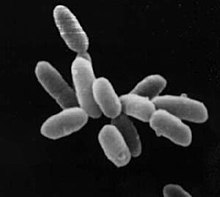Neomura

Neomura(fromAncient Greekneo-"new", andLatin-murus"wall" ) is a proposedcladeofbiological lifecomposed of the twodomainsArchaeaandEukaryota,coined byThomas Cavalier-Smithin 2002.[1]Its name reflects thehypothesisthat both archaea and eukaryotesevolvedout of the domainBacteria,and one of the major changes was the replacement of the bacterialpeptidoglycancell wallswith otherglycoproteins.
As of August 2017[update],the neomuran hypothesis is not accepted by most scientific workers;molecular phylogeniessuggest that eukaryotes are most closely related to one group of archaeans and evolved from them, rather than forming a clade with all archaeans, and that archaea and bacteria aresister groupsboth descended fromLUCA.
Morphology[edit]
Considered as a clade, the Neomura are a very diverse group, containing all of the multicellular species, as well as all of the mostextremophilicspecies, but they all share certain molecular characteristics. All neomurans havehistonesto help withchromosomepackaging, and most haveintrons.All use the moleculemethionineas the initiatoramino acidforprotein synthesis(bacteria useformylmethionine). Finally, all neomurans use several kinds ofRNApolymerase,whereas bacteria use only one.
Phylogeny[edit]
There are several hypotheses for the phylogenetic relationships between archaeans and eukaryotes.
Three-domain view[edit]
WhenCarl Woesefirst published histhree-domain systemin 1990,[2][3]it was believed that the domainsBacteria,Archaea, and Eukaryota were equally old and equally related on the tree of life. However certain evidence began to suggest that Eukaryota and Archaea were more closely related to each other than either was to Bacteria. This evidence included the common use ofcholesterolsandproteasomes,which are complex molecules not found in most bacteria, leading to the inference that the root of life lay between Bacteria on the one hand, and Archaea and Eukaryota combined on the other, i.e. that there were two primary branches of life subsequent to theLUCA– Bacteria and Neomura (not then called by this name).
| |||||||||||||
The "three primary domains" (3D) scenario was one of the two hypotheses considered plausible in a 2010 review of the origin of eukaryotes.[4]
Derived clade view[edit]
In a 2002 paper, and subsequent papers,Thomas Cavalier-Smithand coworkers have promulgated a hypothesis that Neomura was a clade deeply nested with Eubacteria withActinomycetotaas its sister group. He wrote, "Eukaryotes and archaebacteria form the clade neomura and are sisters, as shown decisively by genes fragmented only in archaebacteria and by many sequence trees. This sisterhood refutes all theories that eukaryotes originated by merging an archaebacterium and an α-proteobacterium, which also fail to account for numerous features shared specifically by eukaryotes and actinobacteria."[1]
These include the presence ofcholesterolsandproteasomesin Actinomycetota as well as in Neomura. Features of this complexity are unlikely toevolve more than oncein separate branches, so either there was ahorizontal transferof those two pathways, or Neomura evolved from this particular branch of the bacterial tree.
Two domains view[edit]
As early as 2010, the major competitor to the three domains scenario for the origin of eukaryotes was the "two domains" (2D) scenario, in which eukaryotes emerged from within the archaea.[4]The discovery of a major group within the Archaea,Lokiarchaeota,to which eukaryotes are more genetically similar than to other archaeans, is not consistent with the Neomura hypothesis. Instead, it supports the hypothesis that eukaryotes emerged from within one group of archaeans:[5]
|
Archaea |
A 2016 study using 16 universally-conservedribosomal proteinssupports the 2D view. Its "new view of the tree of life" shows eukaryotes as a small group nested within Archaea, in particular within theTACKsuperphylum. However, the origin of eukaryotes remains unresolved, and the two domain and three domain scenarios remain viable hypotheses.[6]
See also[edit]
References[edit]
- ^abCavalier-Smith T (March 2002)."The phagotrophic origin of eukaryotes and phylogenetic classification of Protozoa".Int. J. Syst. Evol. Microbiol.52(Pt 2): 297–354.doi:10.1099/00207713-52-2-297.PMID11931142.
- ^Woese CR, Fox GE (November 1977)."Phylogenetic structure of the prokaryotic domain: the primary kingdoms".Proceedings of the National Academy of Sciences of the United States of America.74(11): 5088–90.Bibcode:1977PNAS...74.5088W.doi:10.1073/pnas.74.11.5088.PMC432104.PMID270744.
- ^Woese CR, Kandler O, Wheelis ML (June 1990)."Towards a natural system of organisms: proposal for the domains Archaea, Bacteria, and Eucarya".Proceedings of the National Academy of Sciences of the United States of America.87(12): 4576–9.Bibcode:1990PNAS...87.4576W.doi:10.1073/pnas.87.12.4576.PMC54159.PMID2112744.
- ^abGribaldo, Simonetta; Poole, Anthony M.; Daubin, Vincent; Forterre, Patrick & Brochier-Armanet, Céline (2010-10-01). "The origin of eukaryotes and their relationship with the Archaea: are we at a phylogenomic impasse?".Nature Reviews Microbiology.8(10): 743–752.doi:10.1038/nrmicro2426.PMID20844558.S2CID12111029.
- ^López-García, Purificación & Moreira, David (2015)."Open Questions on the Origin of Eukaryotes".Trends in Ecology and Evolution.30(11): 697–708.doi:10.1016/j.tree.2015.09.005.PMC4640172.PMID26455774.
- ^Hug, Laura A.; Baker, Brett J.; Anantharaman, Karthik; Brown, Christopher T.; Probst, Alexander J.; Castelle, Cindy J.; Butterfield, Cristina N.; Hernsdorf, Alex W.; Amano, Yuki; Ise, Kotaro; Suzuki, Yohey; Dudek, Natasha; Relman, David A.; Finstad, Kari M.; Amundson, Ronald; Thomas, Brian C. & Banfield, Jillian F. (2016-04-11)."A new view of the tree of life".Nature Microbiology.1(5): 16048.doi:10.1038/nmicrobiol.2016.48.PMID27572647.
Further reading[edit]
- Cavalier-Smith T (1987). "The origin of eukaryotic and archaebacterial cells".Ann. N. Y. Acad. Sci.503:17–54.doi:10.1111/j.1749-6632.1987.tb40596.x.PMID3113314.S2CID38405158.
- Cavalier-Smith T (January 2002)."The neomuran origin of archaebacteria, the negibacterial root of the universal tree and bacterial megaclassification".Int. J. Syst. Evol. Microbiol.52(Pt 1): 7–76.doi:10.1099/00207713-52-1-7.PMID11837318.
- Cavalier-Smith T (2006)."Rooting the tree of life by transition analyses".Biol. Direct.1:19.doi:10.1186/1745-6150-1-19.PMC1586193.PMID16834776.
- Skophammer RG, Servin JA, Herbold CW, Lake JA (August 2007)."Evidence for a gram-positive, eubacterial root of the tree of life".Mol. Biol. Evol.24(8): 1761–8.doi:10.1093/molbev/msm096.PMID17513883.
- Cox, C. J.; Foster, P. G.; Hirt, R. P.; Harris, S. R.; Embley, T. M. (10 December 2008)."The archaebacterial origin of eukaryotes"(PDF).Proceedings of the National Academy of Sciences.105(51): 20356–20361.doi:10.1073/pnas.0810647105.PMC2629343.PMID19073919.
- Cavalier-Smith, T. (2 September 2014)."The Neomuran Revolution and Phagotrophic Origin of Eukaryotes and Cilia in the Light of Intracellular Coevolution and a Revised Tree of Life".Cold Spring Harbor Perspectives in Biology.6(9): a016006.doi:10.1101/cshperspect.a016006.PMC4142966.PMID25183828.
